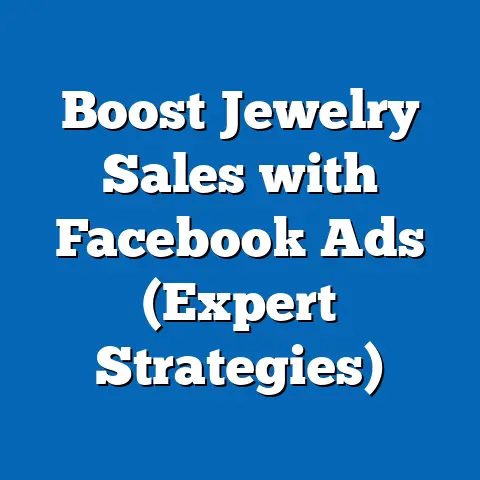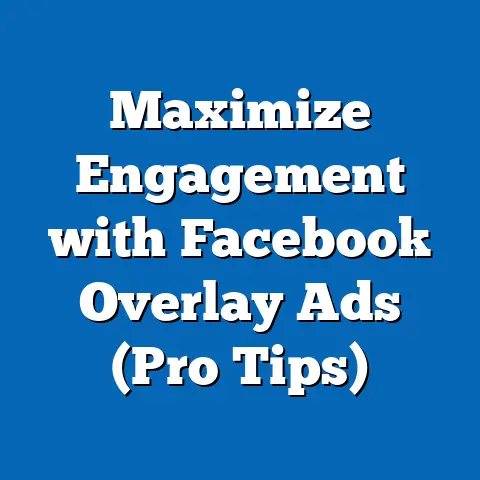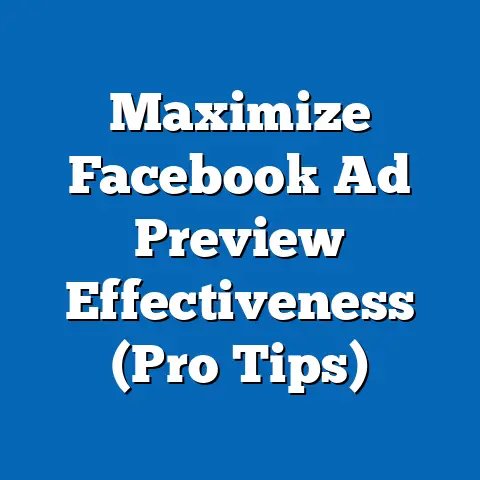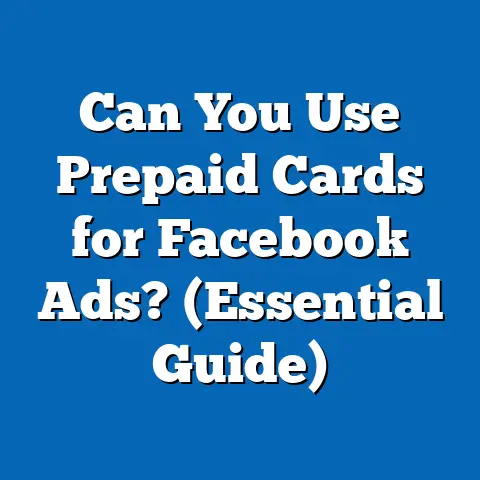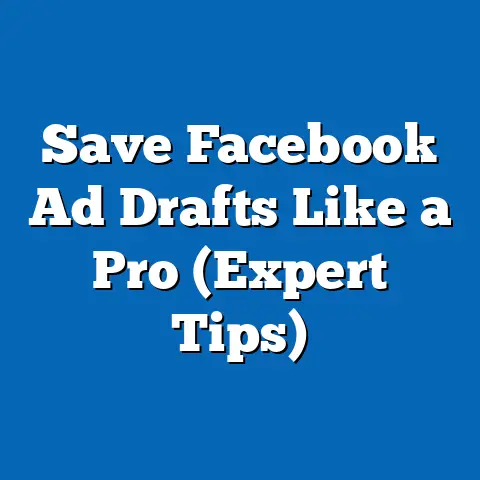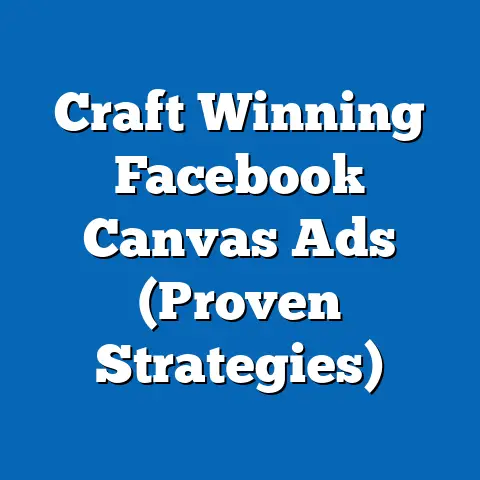Master Facebook Ads Targeting (Unlock Hidden Opportunities)
I remember the first time I felt truly frustrated with Facebook Ads. I was running a campaign for a local bakery, pouring money into what I thought were well-crafted ads, only to see minimal results. It felt like throwing cash into a digital abyss. The clicks were there, but the conversions were… well, nonexistent. It was then that I realized something crucial: a great ad is useless if it’s shown to the wrong people. That’s when I began my deep dive into the world of Facebook Ads targeting, and it completely changed the game.
Have you ever felt like you’re shouting into a void with your Facebook Ads? You’re not alone. Many businesses struggle to see a return on their investment because they haven’t unlocked the true potential of Facebook’s targeting capabilities. In fact, according to a recent study by HubSpot, 61% of marketers say generating leads is their biggest challenge. This often stems from ineffective targeting. But what if I told you that with the right strategies, you could transform your campaigns and connect with exactly the right audience, leading to higher conversions and a better ROI?
Mastering Facebook Ads targeting is like finding the key to a treasure chest filled with potential customers. It’s about understanding the intricate layers of data available to you and using them to pinpoint the people who are most likely to be interested in your products or services. This guide is designed to take you on that journey, helping you unlock hidden opportunities and transform your Facebook Ads from a costly gamble into a powerful marketing tool.
Understanding Facebook’s Targeting Options
Facebook offers a dizzying array of targeting options, and it’s easy to get lost in the details. But understanding the basics is crucial for building a solid foundation for your campaigns. Let’s break down the core categories:
Demographic Targeting
This is your bread-and-butter targeting, focusing on basic characteristics like:
- Age: Targeting specific age ranges allows you to tailor your messaging to different life stages. Selling retirement planning services? Focus on older demographics. Promoting trendy clothing? Target younger audiences.
- Gender: While not always necessary, gender targeting can be useful for products or services that are specifically designed for men or women.
- Education: Target individuals based on their education level, from high school graduates to doctoral degree holders. This is particularly useful for promoting educational programs or career-related services.
- Relationship Status: Target users based on their relationship status (single, in a relationship, married, etc.). This can be helpful for promoting dating apps, wedding services, or relationship advice.
Why it matters: Demographic targeting provides a basic framework for reaching your ideal customer. It’s a good starting point, but it’s rarely enough on its own.
My experience: I once ran a campaign for a local gym that initially targeted anyone aged 18-65 in the surrounding area. After analyzing the data, I realized that the majority of new members were between 25 and 45. By narrowing the age range, I significantly improved the campaign’s performance.
Interest Targeting
This is where things get more interesting. Interest targeting allows you to reach people based on their:
- Hobbies: Target users who are interested in specific hobbies, such as photography, gardening, or cooking.
- Activities: Target users who participate in certain activities, such as hiking, yoga, or playing video games.
- Pages Liked: Target users who have liked specific Facebook pages related to your niche. This is a powerful way to reach people who are already interested in your industry.
Why it matters: Interest targeting allows you to connect with people who have a demonstrated passion for your product or service. It goes beyond basic demographics to tap into their personal interests and passions.
My experience: I was working with an online store that sold handmade jewelry. Instead of just targeting women aged 25-45, I also targeted users who had liked pages related to “handmade crafts,” “Etsy,” and “unique jewelry.” This resulted in a much higher conversion rate.
Behavioral Targeting
This is one of the most powerful targeting options available on Facebook. It allows you to reach people based on their:
- Purchase Behaviors: Target users who have a history of making online purchases in specific categories, such as clothing, electronics, or home goods.
- Device Usage: Target users based on the type of device they use (mobile, desktop, tablet) or their operating system (iOS, Android).
- Travel Habits: Target users who frequently travel or have recently booked a trip.
Why it matters: Behavioral targeting allows you to reach people based on their actual actions and habits. This is incredibly valuable for understanding their needs and desires.
My experience: I was promoting a travel agency that specialized in luxury vacations. I targeted users who had a history of booking luxury travel and who used high-end mobile devices. This resulted in a highly qualified audience that was more likely to convert.
Custom Audiences
Custom Audiences allow you to upload your own data to Facebook and create highly targeted audiences. The most common types of Custom Audiences include:
- Customer Lists: Upload a list of your existing customers’ email addresses or phone numbers to target them directly on Facebook.
- Website Visitors: Use the Facebook Pixel to track visitors to your website and retarget them with relevant ads.
- App Users: Target users who have downloaded and used your mobile app.
Why it matters: Custom Audiences allow you to reach your most valuable customers and prospects with highly personalized messaging.
My experience: I worked with an e-commerce store that had a large email list of past customers. By uploading this list to Facebook, I was able to retarget these customers with exclusive offers and new product announcements, leading to a significant increase in sales.
Lookalike Audiences
Lookalike Audiences allow you to find new customers who are similar to your existing customers. You can create a Lookalike Audience based on:
- Customer List: Facebook will analyze your customer list and find users who share similar characteristics.
- Website Visitors: Facebook will analyze the behavior of your website visitors and find users who exhibit similar browsing patterns.
- Page Likes: Facebook will analyze the demographics and interests of people who like your Facebook page and find similar users.
Why it matters: Lookalike Audiences are a powerful way to expand your reach and find new customers who are likely to be interested in your products or services.
My experience: I was working with a subscription box company that wanted to acquire new customers. I created a Lookalike Audience based on their existing customer list, and the results were phenomenal. The Lookalike Audience significantly outperformed other targeting methods in terms of both acquisition cost and customer lifetime value.
Takeaway: Understanding these core targeting options is essential for creating effective Facebook Ads campaigns. Experiment with different combinations to find what works best for your business.
Unlocking the Power of Data
Targeting isn’t just about selecting the right options; it’s about analyzing the results and refining your approach based on data. Facebook provides a wealth of information that can help you understand your audience and optimize your campaigns.
Facebook Insights and Audience Insights
- Facebook Insights: This tool provides data on your Facebook page’s performance, including demographics, engagement, and reach. Use this information to understand who your existing audience is and what content they respond to.
- Audience Insights: This tool provides data on potential customers, including their demographics, interests, behaviors, and purchase habits. Use this information to identify new targeting opportunities and refine your existing strategies.
How to use them:
- Identify your target audience: Start by defining your ideal customer. What are their demographics, interests, and behaviors?
- Use Audience Insights to research your target audience: Enter your target audience’s characteristics into Audience Insights to learn more about them. What other pages do they like? What are their top interests? What are their purchase habits?
- Use Facebook Insights to analyze your page’s performance: Which posts are performing the best? Who is engaging with your content?
- Refine your targeting: Use the insights you’ve gathered to refine your targeting options and create more effective ads.
My experience: I once ran a campaign for a local restaurant that was struggling to attract new customers. By using Audience Insights, I discovered that their target audience was highly interested in local events and live music. I then created ads that promoted the restaurant’s live music nights and targeted users who had expressed interest in local events. This resulted in a significant increase in foot traffic to the restaurant.
A/B Testing
A/B testing is a crucial part of data-driven targeting. It involves creating multiple versions of your ads and testing them against each other to see which performs best. You can A/B test:
- Different targeting options: Test different demographic, interest, and behavioral targeting options to see which resonates best with your audience.
- Different ad creatives: Test different images, videos, and ad copy to see which grabs your audience’s attention.
- Different calls to action: Test different calls to action to see which drives the most conversions.
How to do it:
- Create multiple versions of your ad: Change one element at a time (e.g., the image, the headline, the call to action).
- Run your ads simultaneously: Make sure each ad is shown to the same audience.
- Track your results: Monitor the performance of each ad and see which performs best.
- Implement the winning version: Once you’ve identified the best-performing ad, use it in your campaign.
My experience: I was running a campaign for an online course and I wasn’t sure which image would resonate best with my audience. I created two versions of the ad, one with a photo of the instructor and one with a graphic of the course curriculum. After running the ads for a week, I discovered that the ad with the photo of the instructor performed significantly better. I then switched to using that ad exclusively, and the campaign’s performance improved dramatically.
Conversion Tracking
Conversion tracking allows you to track the actions that users take after clicking on your ads, such as making a purchase, signing up for a newsletter, or downloading a file. This data is essential for understanding the ROI of your campaigns and optimizing your targeting.
How to set it up:
- Install the Facebook Pixel on your website: The Facebook Pixel is a small piece of code that tracks visitors to your website and their actions.
- Set up conversion events: Define the specific actions that you want to track (e.g., purchases, sign-ups, downloads).
- Track your results: Monitor your conversion data to see which ads and targeting options are driving the most conversions.
My experience: I was working with an e-commerce store that wasn’t tracking conversions. After setting up conversion tracking, I discovered that a significant portion of their sales were coming from users who had viewed a specific product page. I then created a retargeting campaign that showed ads for that product to users who had viewed the page but hadn’t made a purchase. This resulted in a significant increase in sales.
Takeaway: Data is your best friend when it comes to Facebook Ads targeting. Use Facebook Insights, Audience Insights, A/B testing, and conversion tracking to understand your audience, optimize your campaigns, and unlock hidden opportunities.
Niche Targeting Strategies
Once you have a solid understanding of Facebook’s targeting options and the power of data, you can start to explore more advanced niche targeting strategies.
Retargeting
Retargeting is one of the most effective targeting strategies available. It involves showing ads to users who have already interacted with your brand, such as:
- Website Visitors: Retarget users who have visited your website but haven’t made a purchase.
- Page Engagers: Retarget users who have liked, commented on, or shared your Facebook posts.
- Video Viewers: Retarget users who have watched your videos on Facebook.
Why it works: Retargeting is effective because it targets users who are already familiar with your brand and have shown some level of interest in your products or services.
My experience: I worked with an online clothing store that had a high cart abandonment rate. I created a retargeting campaign that showed ads to users who had added items to their cart but hadn’t completed the purchase. The ads featured the items that the users had left in their cart, along with a discount code. This resulted in a significant increase in completed purchases.
Segmentation
Segmentation involves dividing your audience into smaller groups based on shared characteristics, such as demographics, interests, or behaviors. This allows you to create more tailored messages that resonate with each group.
How to do it:
- Identify your audience segments: What are the different groups of people who are interested in your products or services?
- Create tailored messages: Write ad copy and create ad creatives that are specifically designed for each segment.
- Target your ads: Use Facebook’s targeting options to show your ads to the appropriate segments.
My experience: I was running a campaign for a fitness app that targeted both beginners and experienced athletes. I segmented my audience into two groups: beginners and experienced athletes. I then created separate ads for each group, with messaging that was tailored to their specific needs and interests. The ads for beginners focused on the app’s ease of use and its ability to help them get started on their fitness journey. The ads for experienced athletes focused on the app’s advanced features and its ability to help them take their training to the next level. This resulted in a higher conversion rate for both groups.
Layering Targeting Options
Layering targeting options involves combining multiple targeting criteria to pinpoint highly specific audience segments. For example, you could target:
- Women aged 25-35 who are interested in yoga and live in San Francisco.
- Men aged 40-50 who are interested in golf and have a high income.
Why it works: Layering targeting options allows you to reach a highly qualified audience that is more likely to be interested in your products or services.
My experience: I was running a campaign for a luxury watch brand. I layered my targeting options to reach men aged 35-55 who had a high income, were interested in luxury goods, and had a history of making online purchases. This resulted in a highly qualified audience that was more likely to purchase a luxury watch.
Takeaway: Niche targeting strategies can help you reach a more qualified audience and improve the performance of your Facebook Ads campaigns. Experiment with retargeting, segmentation, and layering targeting options to find what works best for your business.
Exploring Hidden Opportunities
Beyond the standard targeting options and niche strategies, there are some hidden opportunities that many advertisers overlook. These can be a goldmine for connecting with highly engaged audiences.
Using Facebook Groups
Facebook Groups are a powerful way to connect with people who share a common interest. You can target users who are members of specific groups or who have expressed interest in topics related to those groups.
How to do it:
- Identify relevant Facebook Groups: Search for groups that are related to your business or industry.
- Target members of those groups: Use Facebook’s targeting options to show ads to members of those groups.
- Create engaging content: Create ads that are relevant to the interests of the group members.
My experience: I was working with a local bookstore that wanted to promote their book club. I identified several Facebook Groups that were focused on reading and books. I then created ads that promoted the bookstore’s book club and targeted members of those groups. This resulted in a significant increase in membership in the book club.
Event Targeting
Event Targeting allows you to target users who have RSVP’d to events that are relevant to your business. For example, you could target users who have RSVP’d to:
- A local conference related to your industry.
- A concert by a band that your target audience likes.
- A charity event that your business is sponsoring.
Why it works: Event Targeting allows you to reach people who are already interested in a specific topic or event.
My experience: I was working with a company that sold software for event planners. I targeted users who had RSVP’d to events related to event planning. This resulted in a highly qualified audience that was more likely to purchase the software.
Utilizing User-Generated Content
User-generated content (UGC) is content that is created by your customers or fans, such as photos, videos, or testimonials. You can use UGC in your ads to create a more authentic and engaging experience for your audience.
How to do it:
- Collect UGC: Encourage your customers to share their photos, videos, and testimonials on social media.
- Get permission: Ask for permission to use their content in your ads.
- Create engaging ads: Use the UGC to create ads that are authentic and relatable.
My experience: I was working with a restaurant that wanted to promote their new menu items. I collected photos of customers enjoying the new menu items and used those photos in my ads. This resulted in a higher click-through rate and a more positive response to the ads.
Takeaway: Don’t be afraid to explore these hidden opportunities to connect with highly engaged audiences and improve the performance of your Facebook Ads campaigns.
Continuous Learning and Adaptation
The world of Facebook Ads is constantly evolving. Facebook is always releasing new features, changing its algorithms, and updating its policies. To stay ahead of the curve, it’s essential to embrace continuous learning and adaptation.
Stay Informed
- Follow industry blogs: Subscribe to blogs that cover Facebook Ads and digital marketing.
- Attend webinars: Attend webinars to learn about new features and best practices.
- Participate in online communities: Join online communities of Facebook Ads experts to share ideas and ask questions.
Experiment and Test
- Try new features: Don’t be afraid to experiment with new features that Facebook releases.
- Test different strategies: Continuously test different targeting options, ad creatives, and calls to action to see what works best for your business.
- Adapt to changes: Be prepared to adapt your strategies as Facebook’s algorithms and policies change.
Analyze Your Results
- Track your performance: Monitor your key metrics, such as reach, engagement, and conversions.
- Identify trends: Look for trends in your data to understand what’s working and what’s not.
- Adjust your strategies: Adjust your strategies based on your results.
My experience: I’ve seen countless changes to the Facebook Ads platform over the years. The key to success is to stay informed, experiment with new features, and continuously analyze your results. For example, when Facebook changed its algorithm to prioritize meaningful interactions, I shifted my focus to creating more engaging content that would encourage users to like, comment, and share. This resulted in a higher reach and a better return on investment.
Takeaway: Continuous learning and adaptation are essential for success in Facebook Ads. Stay informed, experiment with new strategies, and continuously analyze your results to stay ahead of the curve.
Conclusion: The Path to Mastery
Mastering Facebook Ads targeting is an ongoing journey, not a destination. It requires a deep understanding of Facebook’s targeting options, a commitment to data analysis, and a willingness to experiment and adapt. By following the strategies outlined in this guide, you can unlock hidden opportunities and transform your Facebook Ads from a costly gamble into a powerful marketing tool.
Remember, the key to success is to:
- Understand your audience: Who are they? What are their interests? What are their behaviors?
- Use data to refine your targeting: Track your results, analyze your data, and adjust your strategies based on what you learn.
- Experiment with new strategies: Don’t be afraid to try new things.
- Stay informed: Keep up with the latest trends and changes in the world of Facebook Ads.
The potential for growth and success with Facebook Ads is enormous. By mastering the art of targeting, you can reach the right people, with the right message, at the right time, and unlock the hidden potentials that await you.
Now, I encourage you to take the insights you’ve gained from this article and apply them to your own campaigns. Share your experiences with Facebook Ads targeting in the comments below. What strategies have worked for you? What challenges have you faced? Let’s learn from each other and build a community of Facebook Ads masters!

